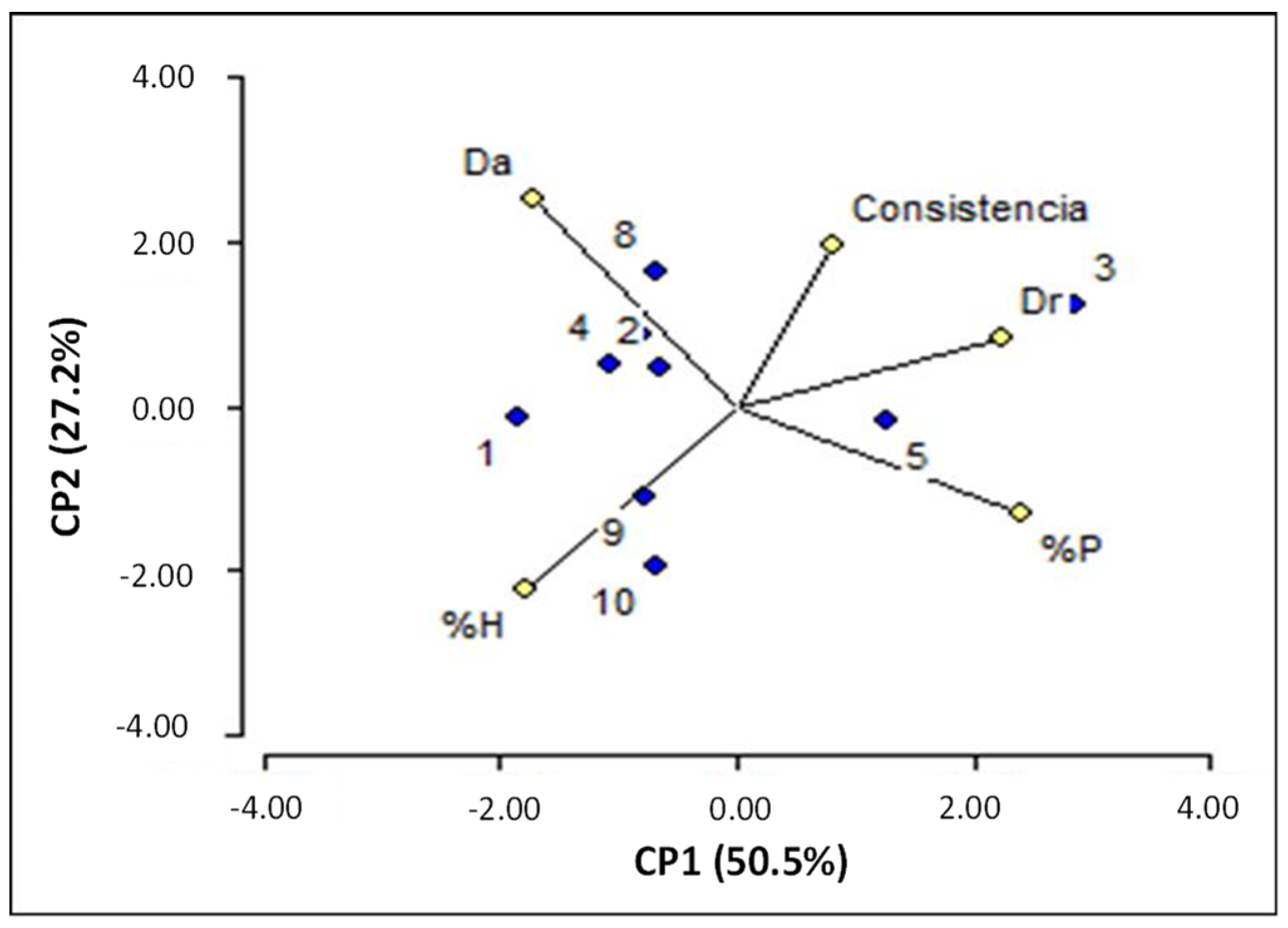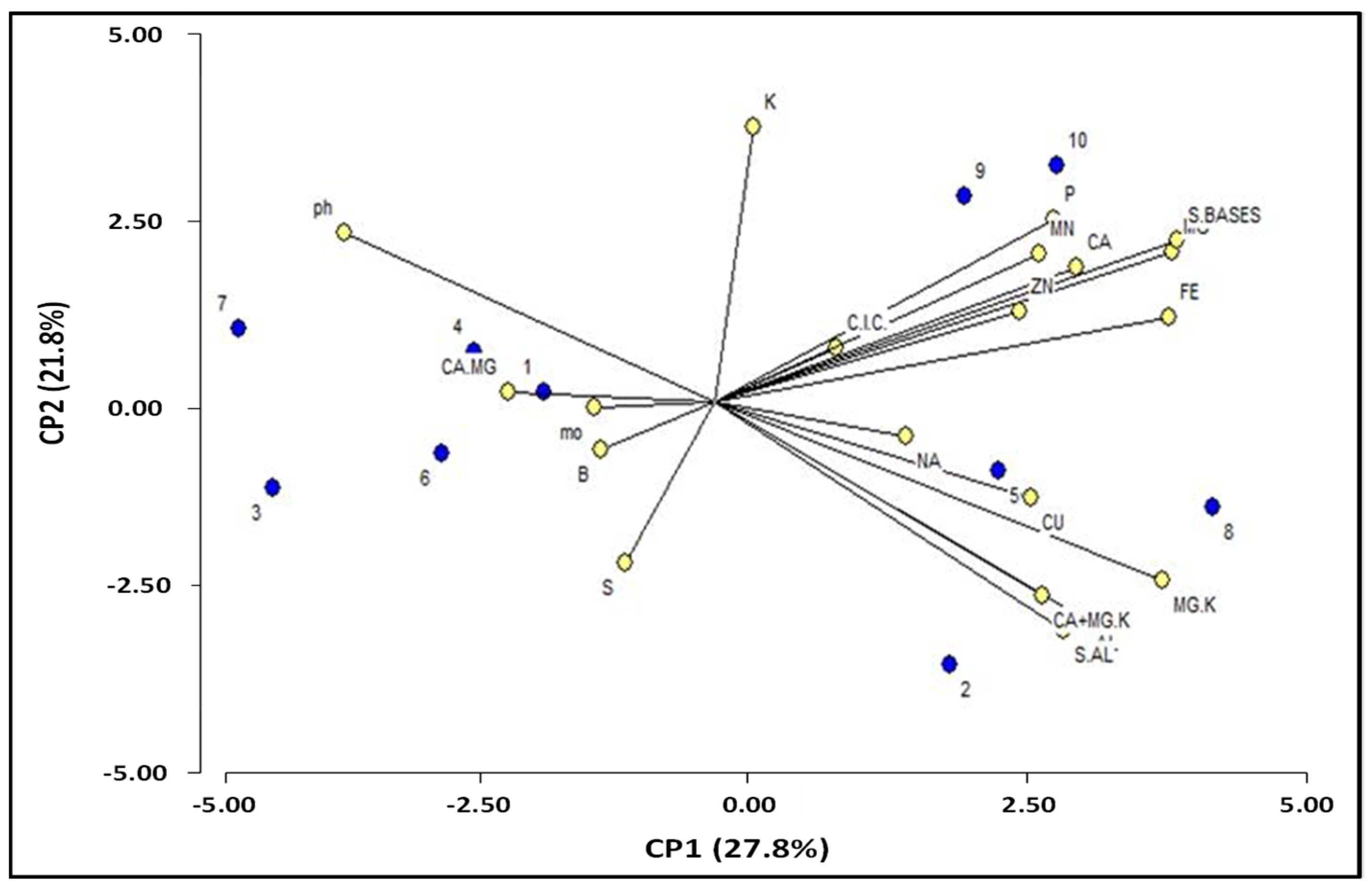1. Introduction
The geodynamic-volcanological processes are natural mechanisms that renew the structure of soils, making a significant contribution of nutrients and thus allowing various groups of plant species to develop and adapt to specific soil conditions. However, several studies show us how the composition and physicochemical characteristics of soils design a vegetal pattern that will predominate over other species, observing how the sustainability of a crop or a forest of forest species, is inherent to the state of the fertility of the soil that provides the nutritional requirements of the plant [
1,
2].
The knowledge of the successional and edaphic processes in areas affected by volcanic eruptions has not been very developed in our territory—a fact that drives to strengthen the research of these processes of the ecological dynamics. For this reason, when commemorating 35 years of the Nevado del Ruiz Volcano eruption that affected the 3500 hectares that conformed the municipality of Armero (Tolima, Colombia), it is important to characterize the relations that exist between the composition of the muds of fluvial-volcanic origin and the structure of the vegetation, having as the base of comparison the three previous studies executed from 1989 to 1999 [
3].
For this reason, the current evaluation of the soil developed from the deposition of fluvial-volcanic muds and its relationship with the different vegetable organizations, a product of a succession process, will allow defining and characterizing how the physicochemical characteristics of soil have modeled the development of vegetation. Thus, we are able to understand in an objective way how the factors of anthropic intervention modify the dynamic of soil–vegetation even more so in a time where productive interests go over ecological ones, for these are the determinants of environmental sustainability and the processes of life on earth.
2. Materials and Methods
2.1. Study Area
The study area is located in the area of influence of fluvial-volcanic mud on the left bank of the Lagunillas River in the municipality of Armero (Tolima, Colombia). The zone has an average temperature of 27.8 °C, average annual precipitation between 1100 and 1960 mm, relative humidity fluctuates between 55% and 83%, and evaporation values reach 1712.8 per year. The region corresponds to the formation of tropical dry forest [
4].
2.2. Sampling and Laboratory Phase
The plots that were constituted correspond to the same sites that were established in the three previous studies for the characterization of the successional vegetation and the edaphological analysis of the mud. Ten plots of 10 × 20 m were raised, in each one, 3 wells were opened to form a composite sample. The soil samples were subjected to physical and chemical analysis to determine the following parameters:
Physical: Texture, porosity (%P), humidity (%H), color, apparent density (Da), real density (Dr).
Chemical: pH, organic matter, cation exchange capacity, major elements (P, Ca, Mg, K,), minor elements (Na, Fe, Cu, Zn, Mn, B, S, Al), aluminum saturation, base saturation, Ca/Mg ratio, (Ca+Mg)/K ratio and Mg/K ratio.
The plant samples were identified in the TOLI Herbarium of the University of Tolima and the COL Herbarium of the Institute of Natural Sciences of the National University of Colombia.
2.3. Data Analysis
The characteristics of the soils of each one of the plots were analyzed using an analysis of the main components of the Infostat program to establish relations between the physical and chemical variables. The relationship between soil composition and vegetation was made through descriptive analysis.
3. Results and Discussion
3.1. Relationship between Physical Variables
The first two factors of the principal component analysis (PCA) explained the 78% variability (
Figure 1). Plots 3 and 5 contributed a percentage of variation of 50% to factor 1, while plots 8, 7, 4, and 2 contributed a percentage of variation of 28% to factor 2.
The variables Dr, %P, Da, and %H were robust and provided information for the analysis; however, no significant groupings between the variables were presented. It was found that the variable Da is influenced by plots 8, 7, 4, and 2, grouping the greatest similarity and negatively correlating with the variable %P. Variable %H is influenced by plots 9 and 10, which is negatively correlated with the variable Dr.
3.2. Relationship between the Chemical Variables
The first four factors of the principal component analysis (PCA) explained the 76% variability. However, among the first two is the 50% variability (
Figure 2). Plots 8, 5, and 2 contributed a percentage of variation of 28% to factor 1, while plots 7, 4, 6, and 3 contributed a percentage of variation of 22% to factor 2.
The variables pH, phosphorus, manganese, zinc, calcium, base saturation, magnesium, iron, copper, Mg/K ratio, (Ca+Mg)/K ratio, aluminum, and aluminum saturation were robust and provided information for the analysis. The variable pH was negatively correlated with the relation of the variables (Ca+Mg)/K, relation Mg/K, aluminum saturation, and aluminum concentration. Sodium and potassium did not present any interaction relation and a positive correlation among the variables phosphorus, manganese, calcium, zinc, base saturation, iron, and magnesium was evidenced.
3.3. Soil–Vegetation Relationship
In the four studies of vegetal succession carried out in the area of Armero affected by fluvial-volcanic mud, 565 species distributed in 72 families were registered from which the families Asteraceae, Malvaceae, Fabaceae, Euphorbiaceae, Cyperaceae, and Poaceae stood out.
Regarding the number of species, a significant variation was found. For the first study, a total of 294 species distributed in 66 families were reported; in the second, 68 families with 332 species; in the third study, 265 species distributed in 45 families were reported; and for the fourth study, a total of 51 families with 195 species were identified. The change in the different concentrations of the physical and chemical parameters has been proportional to the variation in the vegetation. However, the number of tree species has not increased in the studied area. In the same way, the other types of growth do not vary in the four studies, maintaining their percentage constant [
5,
6,
7].
4. Conclusions
The physicochemical characteristics of the soil show a considerable change during the 35 years after the volcanic eruption, and currently, the variables show levels suitable for the development of vegetation.
The physical variables of the soil have established conditions for the development of vegetation through optimal levels of moisture, porosity, and a structure that facilitates the movement and uptake of nutrients from the roots.
As for the chemical variables, an acidic pH is maintained that does not drastically affect the vegetation but it decreases the concentration of organic matter and elements such as phosphorus and potassium. However, other elements such as iron present adequate levels for the maintenance of the plant’s physiological demand.
The edaphic conditions are directly related to the establishment of the successional vegetation in an alternate ecological process to the natural and human disturbances in an evident way with dominant species in the first years of the process, and which, at the moment, are scarce (Rhynchelitrum roseum, Sarcostemma clausum, Mariscus ligularis, and Indigofera hirsuta).
Author Contributions
All authors contributed equally to this work. All authors discussed the results and implications, and commented on the manuscript at all stages. A.T.-B. and H.E. wrote the paper. All authors have read and agreed to the published version of the manuscript.
Funding
This research was funded by Office of Research and Scientific Development of the University of Tolima.
Acknowledgments
We are grateful to the TOLI Herbarium and Soil Laboratory of the University of Tolima for their support in the analysis of plant and soil samples.
Conflicts of Interest
The authors declare no conflict of interest.
References
- Cantillo, E.; Lozada, A.; Pinzón, J. Successional characterization for the restoration of the forest reserve Cárpatos, Guasca, Cundinamarca. Rev. Colomb. For. 2009, 12, 103–118. [Google Scholar]
- Torres, A.; Adarve, J.; Cárdenas, M.; Vargas, J.; Londoño, V.; Rivera, K.; Home, J.; Duque, O.; González, A. Successional dynamics of a tropical dry forest fragment in the Cauca Valley, Colombia. Biota Colomb. 2012, 13, 66–88. [Google Scholar]
- Gómez, A. The Colombian Andean Zone. Soil Erosion and Conservation; CENICAFÉ: Caldas, Colombia, 1988. [Google Scholar]
- Holdridge, L. Ecology Based on Life Zones; CATIE: San José, Costa Rica, 1979. [Google Scholar]
- Esquivel, H.; Leguizamón, G. Floristic Study of the Region Covered by Fluvio-Volcanic Mud in the Area, as a Consequence of the Eruption of the Nevado del Ruiz Volcano in 1985. Specialization Thesis, Tolima University, Tolima, Colombia, 1989. [Google Scholar]
- Esquivel, H.; Ramírez, L. Successional Study of the Fluvial-Volcanic Mud of the Municipality of Armero. Specialization Thesis, Tolima University, Tolima, Colombia, 1994. [Google Scholar]
- Esquivel, H.; Frye, A.; Ramírez, L. State of the Vegetal and Edaphological Succession of the Muds of Armero 15 Years After the Eruption of the Arenas del Nevado del Ruiz Volcano; University of Tolima Publisher: Tolima, Colombia, 1999. [Google Scholar]
| Publisher’s Note: MDPI stays neutral with regard to jurisdictional claims in published maps and institutional affiliations. |
© 2020 by the authors. Licensee MDPI, Basel, Switzerland. This article is an open access article distributed under the terms and conditions of the Creative Commons Attribution (CC BY) license (https://creativecommons.org/licenses/by/4.0/).







